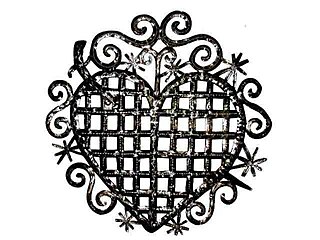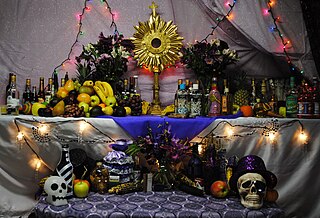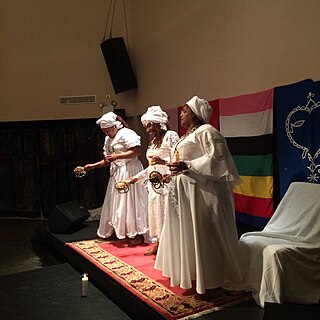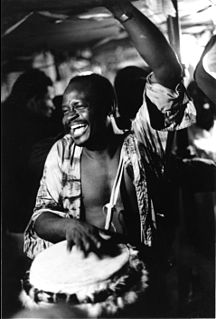
The loa are the spirits of Haitian Vodou and Louisiana Voodoo. They are intermediaries between Bondye – the Supreme Creator, who is distant from the world – and humanity. Unlike saints or angels, however, they are not simply prayed to, they are served. They are each distinct beings with their own personal likes and dislikes, distinct sacred rhythms, songs, dances, ritual symbols, and special modes of service. Contrary to popular belief, the loa are not deities in and of themselves; they are intermediaries for, and dependent on, a distant Bondye or god.

Vodun is practiced by the Aja, Ewe, and Fon peoples of Benin, Togo, Ghana, and Nigeria.

Damballa, also spelled Damballah, Dambala, Dambalah, among other variations, is one of the most important of all loa, spirits in Haitian Vodou and Louisiana Voodoo traditions. He is portrayed as a great white serpent, originating in the city of Wedo in modern-day Benin. Damballa is said to be the Sky Father and the primordial creator of all life, or the first thing created by Gran Met. In those Vodou societies that view Damballa as the primordial creator, he created the cosmos by using his 7,000 coils to form the stars and the planets in the heavens and to shape the hills and valleys on earth. In others, being the first thing created by God, creation was undertaken through him. By shedding the serpent skin, Damballa created all the waters on the earth. As a serpent, he moves between land and water, generating life, and through the earth, uniting the land with the waters below. Damballa is usually syncretized with either Saint Patrick or Moses. He is counted among the Rada loa.

Simbi is a large and diverse family of serpents also known as loa in Haitian Vodou. Some names for the Simbi loa include Simbi Dlo, Simbi Makaya, Simbi Andezo, and Gran Simba. Traditionally in their Kongo context, they are all associated with water, but in the Haitian Vodoun context they have wide-ranging associations. For example, Simbi Makaya is a great sorcerer and served in particular in the Sanpwel secret societies. Simbi Anpaka is a loa of plants, leaves, and poisons.

Ezilí Dantor or Erzulie Dantó is the main loa or senior spirit of the Petro family in Haitian Vodou.
Haitian Vodou is a syncretic mixture of Roman Catholic rituals developed during the French colonial period, based on traditional African beliefs, with roots in Dahomey, Kongo and Yoruba traditions, and folkloric influence from the indigenous Taino peoples of Haiti. The Loa, or spirits with whom Vodouisants work and practice, are not gods but servants of the Supreme Creator Bondye. In keeping with the French-Catholic influence of the faith, vodousaints are for the most part monotheists, believing that the Loa are great and powerful forces in the world with whom humans interact and vice versa, resulting in a symbiotic relationship intended to bring both humans and the Loa back to Bondye. "Vodou is a religious practice, a faith that points toward an intimate knowledge of God, and offers its practitioners a means to come into communion with the Divine, through an ever evolving paradigm of dance, song and prayers."
Palo, also known as Palo Monte and Las Reglas de Congo, is an African diasporic religion that developed in Cuba. It arose through a process of syncretism between the traditional Kongo religion of Central Africa, the Roman Catholic form of Christianity, and Spiritism. Initiates in the religion are termed paleros (male) or paleras (female).

Houngan or oungan is the term for a male priest in Haitian Vodou. The term is derived from the Fon word hounnongan. Houngans are also known as makandals.

Homosexuality in Haitian Vodou is religiously acceptable and homosexuals are allowed to participate in all religious activities. However, in countries with large Vodou populations, some Christian influence may have given homosexuality a social stigma, at least on some levels of society.
The Petwo, in older sources sometimes spelled Petro, and alternatively known as dompete, are a family of lwa spirits in the religion of Haitian Vodou. They are regarded as being volatile and "hot", in this contrasting with the Rada lwa, which are regarded as sweet-tempered and "cool."

A mambo is a priestess in the Haitian Vodou religion. Haitian Vodou's conceptions of priesthood stem from the religious traditions of enslaved people from Dahomey, in what is today Benin. For instance, the term mambo derives from the Fon word nanbo. Like their West African counterparts, Haitian mambos are female leaders in Vodou temples who perform healing work and guide others during complex rituals. This form of female leadership is prevalent in urban centers such as Port-au-Prince. Typically, there is no hierarchy among mambos and houngans. These priestesses and priests serve as the heads of autonomous religious groups and exert their authority over the devotees or spiritual servants in their hounfo (temples). Mambos and houngans are called into power via spirit possession or the revelations in a dream. They become qualified after completing several initiation rituals and technical training exercises where they learn the Vodou spirits by their names, attributes, and symbols. The first step in initiation is lave tèt, which is aimed at the spirits housed in an individual's head. The second step is known as kouche, which is when the initiate enters a period of seclusion. Typically, the final step is the possession of the ason, which enables the mambos or houngan to begin their work. One of the main goals of Vodou initiation ceremonies is to strengthen the mambo's konesans (knowledge), which determines priestly power.

Haitian Vodou is an African diasporic religion that gradually developed in Haiti between the 16th and 19th centuries. It arose through a process of syncretism between the traditional religions of West Africa and the Roman Catholic form of Christianity. Adherents are known as Vodouists or "servants of the spirits". There is no central authority in control of Vodou, which is organised through autonomous groups.
Vodou drumming and associated ceremonies are folk ritual faith system of henotheistic religion of Haitian Vodou originated and inextricable part of Haitian culture.
Mama Lola is the nickname of a prominent Vodou spiritual and arts and culture leader in the United States. In 1991, the late Karen McCarthy Brown published the first edition of Mama Lola: A Vodou Priestess in Brooklyn, an ethnography based on the life of her research collaborator and friend since 1978, Alourdes. For the purposes of protecting the privacy of Alourdes and her family, Brown modified certain details of her life like her birthdate and name and the names of her descendants. The initial pseudonym attributed to Alourdes was "Marie Thérèse Alourdes Macena Margaux Kowalski". Already a prominent leader in her Brooklyn community and with strong ties maintained with her mother's neighborhood in Port-au-Prince, Alourdes rose to greater public prominence as she increasingly participated in the arts and culture fields, academia, and other spiritual communities in the United States in the wake of the publication of the book. She increasingly used the nickname in her public appearances and also disclosed her full name at these venues. In the second edition of the book in 2001, Brown published Alourdes's full legal name, "Marie Thérèse Alourdes Macena Champagne Lovinski". According to Brown, " ... Alourdes combines the skills of a medical doctor, a psychotherapist, a social worker, and a priest." (5) Among the many spiritual communities that she now advises, Brown's research collaborator and friend Alourdes serves on occasion as a manbo (mambo) in a cultural center in New Orleans, Louisiana. The information that follows within this Wikipedia entry is derived mainly from the book in its first, second, and third editions. This Wikipedia entry reuses the pseudonyms Brown conferred on the people in Alourdes's life and some of the ways Brown combined accounts and created composite characters, or, as one notable scholar and artist writes about the book, how Brown took "creative liberties fictionalizing various strands of Lola’s familial and spiritual genealogies." This Wikipedia entry also uses current Haitian Creole (Kreyòl) spelling in the description of the spiritual entities of Vodou, which have other spellings in French and other iterations of French Creole languages.
Leslie G Desmangles is an author and college professor focusing his research on Haiti and religion.

Frisner Augustin was a major performer and composer of Haitian Vodou drumming, and the first and only citizen of Haiti to win a National Heritage Fellowship from the National Endowment for the Arts in the United States, where he resided for forty years.

Haitian Vodou art is art related to the Haitian Vodou religion. This religion has its roots in West African traditional religions brought to Haiti by slaves, but has assimilated elements from Europe and the Americas and continues to evolve. The most distinctive Vodou art form is the drapo Vodou, an embroidered flag often decorated with sequins or beads, but the term covers a wide range of visual art forms including paintings, embroidered clothing, clay or wooden figures, musical instruments and assemblages. Since the 1950s there has been growing demand for Vodou art by tourists and collectors.
Pierrot Barra (1942–1999) was a Haitian Vodou artist and priest, who was president of a Bizango society. He was well-known for his use of diverse materials to create “Vodou Things,” which functioned as charms or altars for the Vodou religion.
Filomez is a loa that belongs to the Rada nation. She is a water spirit that is served with pastel colors such as blue, pink, and sometimes even green. In some Vodou houses, she is the younger sister of Erzulie Freda. In others, she is not. Filomez is considered to be a very rare, yet potent, loa.
Erzulie nennen O, also known simply as Erzulie, is a song composed at age 14 by the Haitian singer Kandjo (1879-1947), also known as Auguste de Pradines. Erzulie is often said to be one of his most beloved songs. Composed in the 1890s, the song continued to be played as "part of the Haitian folkloric repertory" at the end of the 20th century, more than 100 years after its composition.










